Setting the Record Straight: Benchmarking the Biden Years
The macroeconomic performance over the course of the Biden-Harris Administration didn’t just beat forecasters expectations repeatedly, but policy changes and bold, new legislation led to strong progress in growth, productivity, jobs, incomes, investment and entrepreneurship. As we reflect on the Administration’s record over the last four years, the following indicators will help benchmark where the economy is as the next administration takes over.
Growth & Productivity
While all economies suffered from the pandemic, real GDP recovered much faster and surpassed its pre-COVID level well before other G7 countries. The robust U.S. economic performance was fueled by comparatively strong productivity growth, which was stronger than in any country in the G7. In fact, the US is only one of three G7 countries that has had stronger productivity growth since the pandemic than the business cycle prior to it. Equally remarkably, productivity growth has stayed strong over the last two years, whereas in most G7 countries it has fallen compared to the first few years of the pandemic period. As Figure 2 shows, U.S. productivity growth over the past two years was 1.9%, 2.2 ppts higher than the average rate of the rest of the G7.

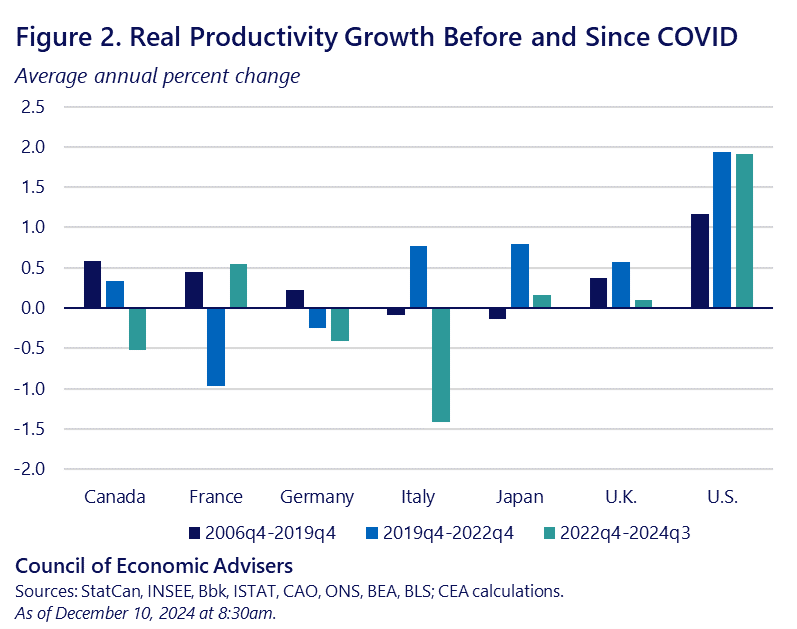
Entrepreneurship
Since January 2021, 20 million new business applications have been filed. It has been hypothesized that the application surge was driven by two waves. Pandemic-specific entrepreneurial opportunities, such as producing masks, may have contributed to the first wave while the second may have been related to pandemic uncertainty resolving for entrepreneurs (Decker and Haltiwanger 2023). Given new businesses are an important vehicle for job creation (Haltiwanger 2015), the surge may boost tomorrow’s labor market and future economic growth.
As part of President Biden’s Investing in America agenda and the Vice President’s 2023 Call to Action, there’s been significant progress on expanding capital access for underserved communities. The share of SBA 7(a) and 504 loans going to Black-owned Businesses has more than doubled between 2020 and 2023. Additionally, the share of Black and Hispanic families with business ownership rose between 2019 and 2022.
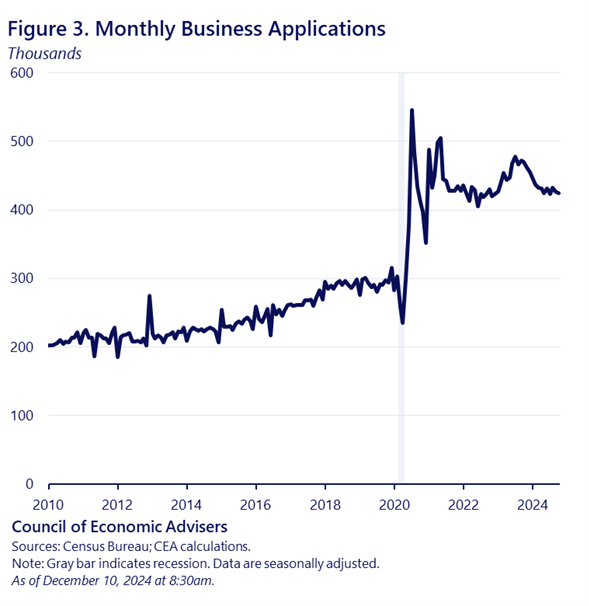
Investment
Over the last four years, there’s been substantial manufacturing investment. As a share of nominal GDP, investment in manufacturing structures rose to the highest level in 2024 Q2 since 1982.
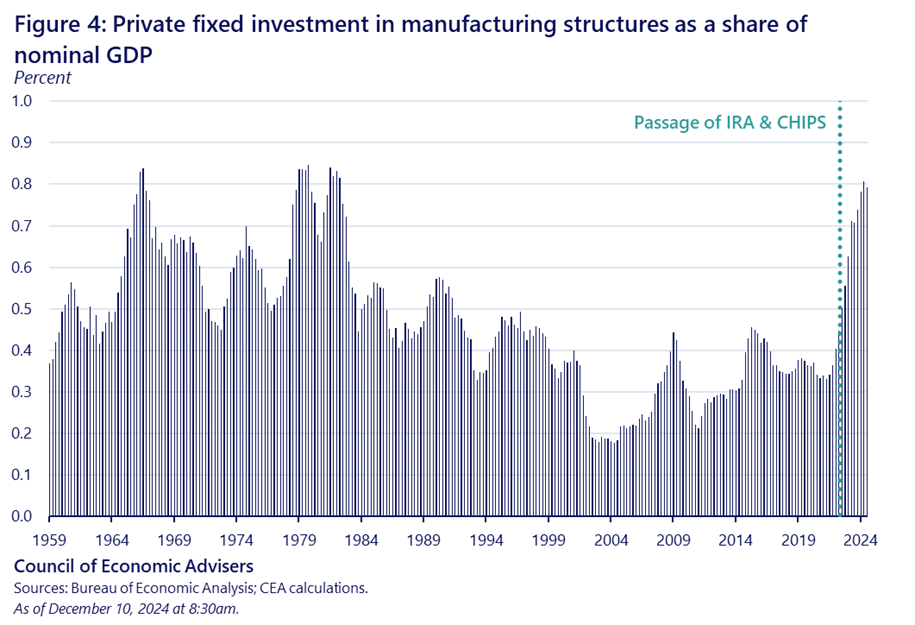
Foreign Direct Investment (FDI), that is investment flows into the United States, have also risen in select categories. Clean energy and manufacturing of clean energy FDI has increased more than seven times since the prior administration, allowing business to hire more workers and increase factory production. These investment flows provide much needed capital to American entrepreneurs who, in turn, create high-quality manufacturing and energy jobs. Much of this inflow in likely due to the historic legislation of the IRA and CHIPS acts, passed by the Biden-Harris Administration. And this legislation helped ‘crowd in’ $1 trillion of total private investment commitments as of November 2024.


Labor market
The national unemployment rate has been remarkably low for the last several years into the economy recovery. It remains low in historical context, with the annual unemployment rate being lower in only 17 percent of years since 1948.

Payroll employment has also been exceptional, seeing monthly gains well above their 2019 pace as the economy recovered from the pandemic and then settled into a robust expansion. In the three months ending in November 2024, the average pace of payroll growth was 173,000 per month.

While there have been a numerous of labor market records hit during the last four years, prime age participation is particularly notable. Despite a catastrophic pandemic, prime-age women’s participation has recovered, resumed its pre-pandemic upward trend, and reached a series high in August 2024. More surprisingly, prime-age men’s participation has now risen above its pre-pandemic rate, counter to many previous decades of decline.

Further as seen in Figure 10, since January 2021, the labor force participation rate of mothers with young children has increased by 3.4 percentage points to record highs. This increase is due, in part, to the Biden-Harris Administration’s efforts to increase access to affordable child care and early childhood education as CEA has referenced in past blogs.

Along with these improvements in labor force participation have come a narrowing of long-standing disparities. Strong labor markets are especially beneficial for disadvantaged workers, and this has been particularly the case since the pandemic recession. Declining participation gaps by race, shown below, are one good example. Note, for example, how the Black participation rate minus the overall rate went from -3.5 ppts to -1.4 ppts, from March 2021 to November 2024.

The strong economic growth record has led to a virtuous cycle of strong consumption growth, boosting labor demand, further raising incomes, and thereby consumption. In fact, incomes have outpaced prices recently due to the strong labor market and broadly easing inflation. After-tax personal income before government transfers—reflecting labor, business and asset-derived incomes—increased about $3,800 (8%) per person in real terms from Jan. 2021 to Oct. 2024.

International Trade
Trade with America’s strategic partners has grown under the Biden-Harris administration, and key geopolitical allies such as Canada now represent a greater share of U.S. imports. The United States’ dependence on Chinese imports has also fallen dramatically, allowing American trade to be more diversified and resilient.

Health Insurance Coverage and Marketplace Enrollment
Rates of uninsurance reached historic lows starting in the first quarter of 2022. Low rates of uninsurance were maintained during the unwinding of pandemic-era Medicaid coverage in 2023 and 2024. Marketplace enrollment also reached a record high at 14.5 million in 2022 and then continued to grow, reaching 16.4 million in 2023 and 21.4 million in 2024.


Climate
The Biden-Harris Administration enacted three historic polices that promoted clean energy: the Bipartisan Infrastructure Law, CHIPS and Science Act, and the Inflation Reduction Act. These laws led to rapid increases in both investment and employment in the clean energy sector. Investment in the clean energy sector has reached all-time highs of more than $70 billion dollars in 2024:Q3.
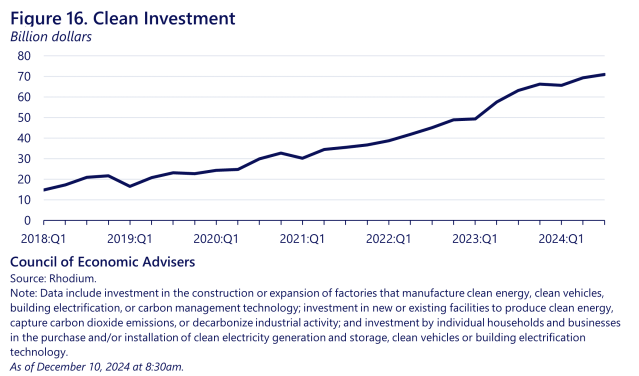
Total growth in clean energy jobs increased almost 5 percent between 2022-2023, and in levels, currently stands at nearly 3.2 million in 2023. Employment in electric power generation has increased more than 10% during the Biden-Harris Administration and most of this gain has come from clean sources of generation.
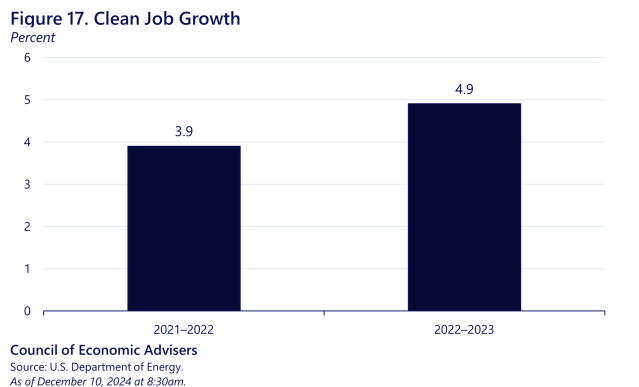
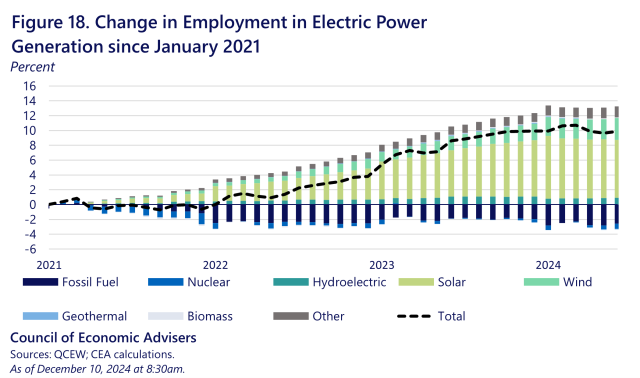
Where we go from here
While the figures above go through many economic trends, to summarize, the following table sets key benchmark levels and rates against which we can judge progress going forward. It has been an honor of the Biden-Harris CEA to track the tremendous economic progress of the last four years.

